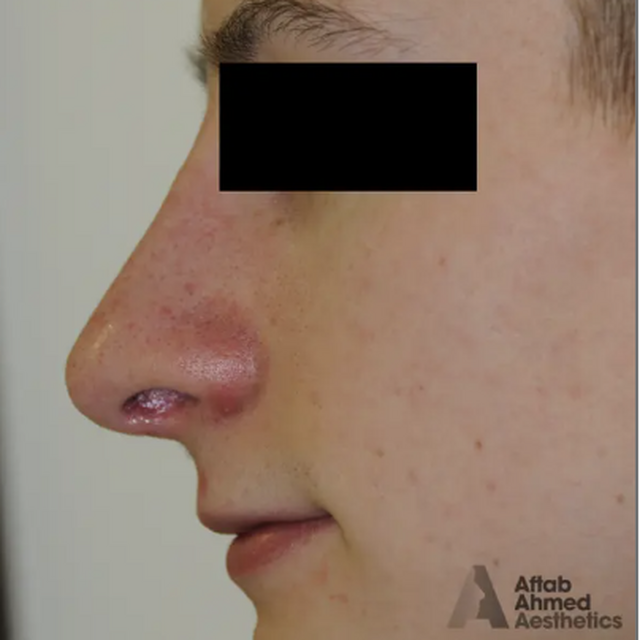Can You Breathe Better After Rhinoplasty?
18th September 2025 |
By Shan Harland

Rhinoplasty and Breathing – What’s the Link?
While rhinoplasty is often thought of as a cosmetic procedure, many patients also seek it to address breathing issues. Problems with nasal breathing can stem from a variety of causes, including a deviated septum, nasal obstruction, or narrow nasal passages, all of which can impact your ability to breathe through the nose comfortably.
If you've been living with breathing difficulties or long-standing nasal congestion, you might wonder: can you breathe better after rhinoplasty? The answer is yes, in many cases. By correcting internal structural issues, nose surgery can help to improve breathing and make nasal airflow more efficient.
While not everyone who undergoes a rhinoplasty procedure is looking to fix breathing problems, many people do notice a significant improvement in how easily they can breathe after the surgical procedure, especially if their operation addressed both aesthetic and functional concerns.
When Is Rhinoplasty Done to Improve Breathing?
Not all nose jobs are performed purely for cosmetic reasons. Many people turn to rhinoplasty surgery to relieve ongoing breathing problems, particularly when there's an underlying structural issue inside the nose. This is known as functional rhinoplasty, and it’s often recommended when patients experience one or more of the following:
- A deviated septum, where the nasal septum (the wall between the nostrils) is off-centre, causing one or both nasal passages to narrow.
- Nasal obstruction due to trauma, injury, or congenital differences in the nose's structure.
- Weak or collapsed nasal valves that obstruct airflow, especially during deep breathing or physical activity.
- Chronic nasal congestion that doesn’t improve with saline nasal sprays or prescribed medications.
In these situations, nasal surgery aims to restore proper nasal function by adjusting the structure inside the nose, improving nasal airflow and reducing breathing difficulties. Some procedures may involve the use of spreader grafts to support weakened areas or correct collapse.
Many patients are surprised to find that improving the internal structure of their nose often leads to better sleep, fewer health problems linked to poor airflow, and a noticeable improvement in breathing through the nose.
How Soon After Surgery Will I Notice a Difference?
It’s common to expect immediate results after rhinoplasty surgery, but when it comes to breathing improvement, patience is key. During the initial recovery period, many patients experience nasal congestion, swelling, and even temporary blockage. This is a normal part of the healing process and doesn't mean the surgery hasn’t worked.
In the first few days, nasal tissues can be inflamed and sensitive, especially if nasal packing was used or the nasal bone was adjusted. Most patients begin to feel gradual improvement in their nasal breathing around 3 to 6 weeks after surgery, as the swelling inside the nose reduces.
For those who’ve had a deviated septum corrected or structural support added, such as with spreader grafts, noticeable changes in breathing function may continue to develop over several months. The full benefit to nasal airflow often becomes clear once the internal swelling has completely resolved, usually by the 3 to 6 month mark, though this can vary.
Following your surgeon's instructions during the recovery process, such as keeping your head elevated and attending regular follow-up appointments, helps support proper healing and better long-term outcomes.
What if I Only Want a Cosmetic Rhinoplasty?
Even if you're considering nose surgery purely for cosmetic reasons, it's important not to overlook any existing breathing issues. A well-planned rhinoplasty procedure can often address both aesthetic and functional elements of the nose at the same time.
During your consultation, an experienced surgeon will assess your nasal passages, look for signs of a deviated septum, and ask about any history of nasal congestion or breathing problems. This thorough physical exam helps avoid complications where cosmetic changes might unintentionally obstruct airflow or affect the nose’s internal support.
Many patients are surprised to learn that subtle external changes, such as refining a dorsal hump or adjusting the nasal tip can sometimes influence nasal breathing, especially if not planned carefully. That’s why choosing a board certified plastic surgeon who understands both the appearance and function of the nose is so important.
If you're only concerned with how your nose looks but also happen to suffer from problems breathing, it's worth exploring whether these concerns can be addressed in one surgical procedure, potentially saving time, cost, and recovery down the line.
Will I Need a Septoplasty Too?
If you’re dealing with a deviated septum, your surgeon may recommend combining your rhinoplasty procedure with a septoplasty. While rhinoplasty reshapes the outer appearance of the nose, septoplasty focuses on correcting the nasal septum, the thin wall of cartilage and bone that separates your nasal passages.
A deviated septum is one of the most common causes of nasal obstruction, and can lead to chronic nasal congestion, breathing difficulties, and even recurring sinus infections. Straightening the septum can significantly improve breathing by allowing better nasal airflow and more proper drainage.
In many cases, combining the two procedures makes sense, not only from a surgical perspective, but also in terms of your recovery process. Instead of undergoing two separate surgeries, both your aesthetic and functional concerns can often be addressed in one operation, with a single healing process and downtime.
Your surgeon will advise whether a septoplasty is necessary based on your symptoms, a detailed physical exam, and imaging if needed. For many patients, the result is a significant improvement in both appearance and the ability to breathe through the nose.
Can Rhinoplasty Make Breathing Worse?
While rhinoplasty surgery can often improve breathing, it’s important to be aware that, in some cases, it may lead to new breathing problems, especially if not performed carefully.
If too much cartilage is removed, or if the nose’s structure is weakened during the procedure, it can result in nasal valve collapse where the sides of the nose cave in during inhalation. This can obstruct airflow and make breathing through the nose more difficult than before.
Other complications may include septal perforation (a small hole in the nasal septum) or internal scarring that affects nasal function. These issues are uncommon but can lead to persistent nasal congestion, whistling sounds when breathing, or general discomfort during inhalation.
This is why it's essential to choose a board certified plastic surgeon who understands both the aesthetic and structural aspects of the nose. A functional assessment should always be part of the surgical plan, even if the operation is primarily cosmetic to avoid disrupting natural nasal airflow.
If you’ve had a nose job elsewhere and are now experiencing new or worsened breathing difficulties, a revision rhinoplasty may be required to restore proper nasal breathing.
Rhinoplasty with Mr Aftab Ahmed
If you're considering nose surgery for either aesthetic or functional concerns, choosing the right surgeon is essential, especially when it comes to addressing breathing problems safely and effectively.
Mr Aftab Ahmed is a Consultant ENT and Facial Plastic Surgeon with extensive experience in both cosmetic and functional rhinoplasty procedures. Whether you're looking to reshape your nose, correct a deviated septum, or relieve long-standing nasal obstruction, you'll receive a tailored approach built around your needs.
Patients benefit from:
- Same-day appointments available across Nottingham and Doncaster
- A full nasal breathing assessment and structured treatment plan
- Surgery performed at high-quality, well-equipped private hospitals
- Aftercare that supports your full healing process and long-term outcomes
As a board certified and medically trained ENT specialist, Mr Ahmed combines precision, safety, and a clear understanding of how the nose functions, ensuring that cosmetic changes never come at the cost of your ability to breathe comfortably.
Frequently Asked Questions about Rhinoplasty
How long does rhinoplasty take?
The rhinoplasty procedure typically takes between 1.5 to 3 hours, depending on the complexity of the case. If you're having both cosmetic and functional elements addressed such as correcting a deviated septum or improving nasal airflow, the surgery may take slightly longer. Your surgeon will give you a more accurate timeframe during your consultation.
How long is recovery after rhinoplasty?
Most patients can return to light daily activities within 7 to 10 days, but the full recovery process takes longer. During the initial recovery period, expect nasal congestion, significant swelling, and mild discomfort. These symptoms gradually settle over several weeks, with most breathing improvement and visible results becoming clearer between 3 and 6 months.
You’ll be given detailed post-op advice, which may include using saline nasal sprays, sleeping with your head elevated, and taking any prescribed medications. Regular follow-up appointments help track healing and ensure the best possible outcome.
